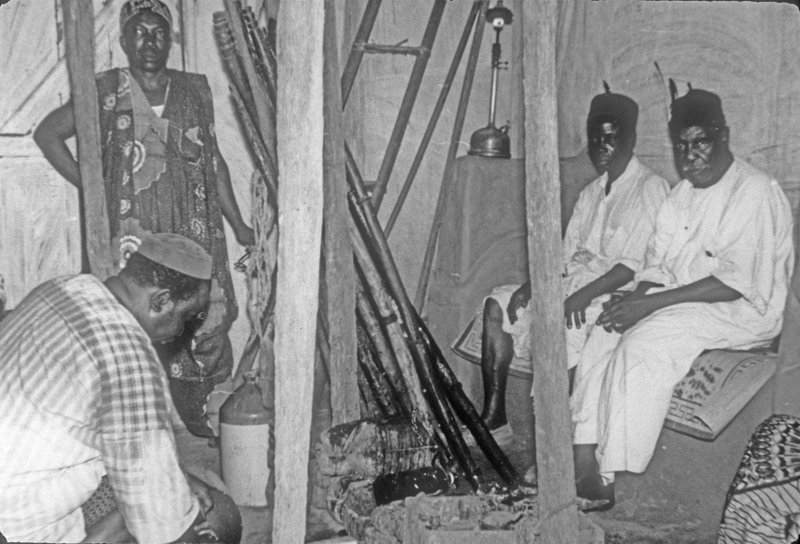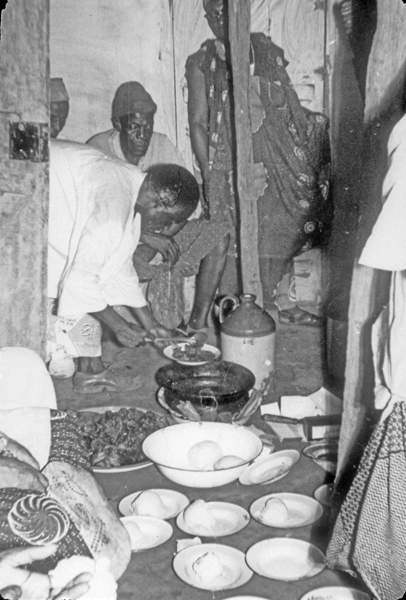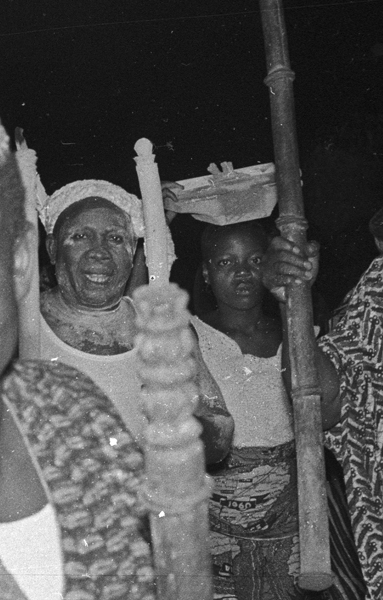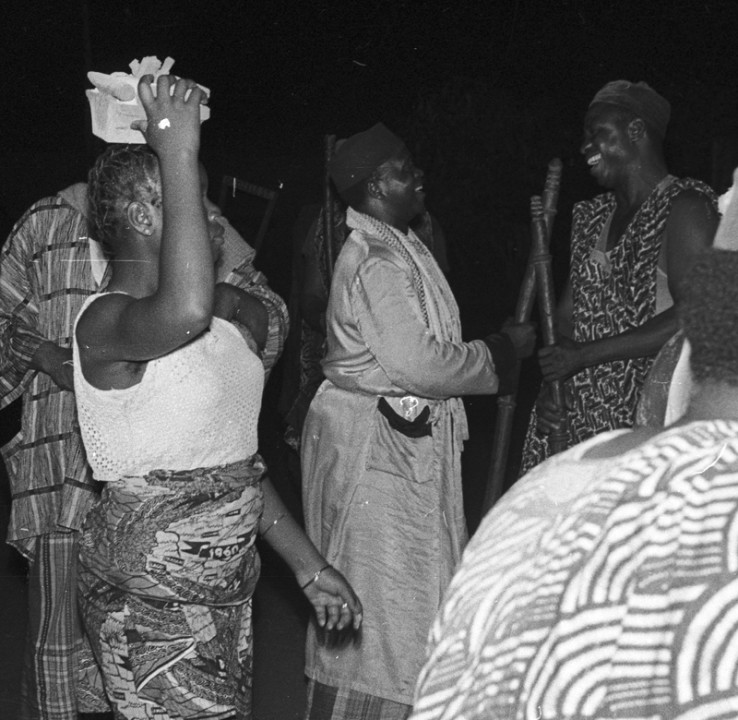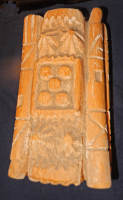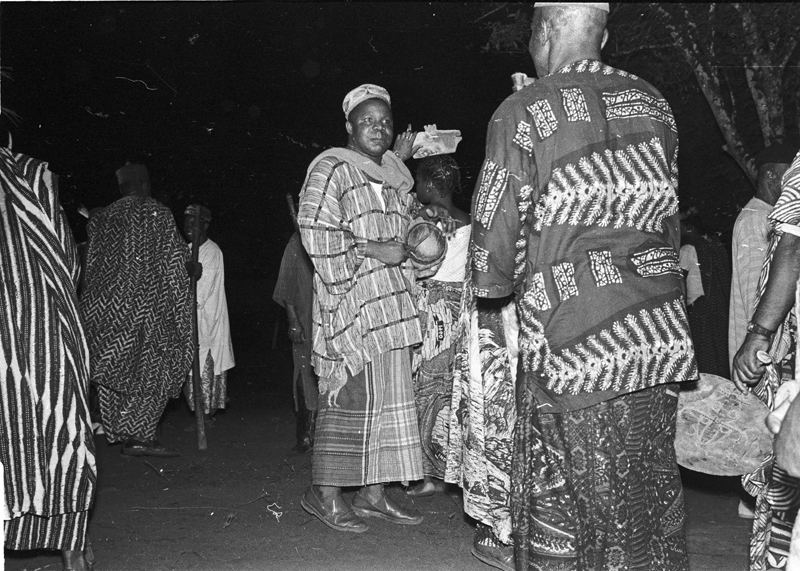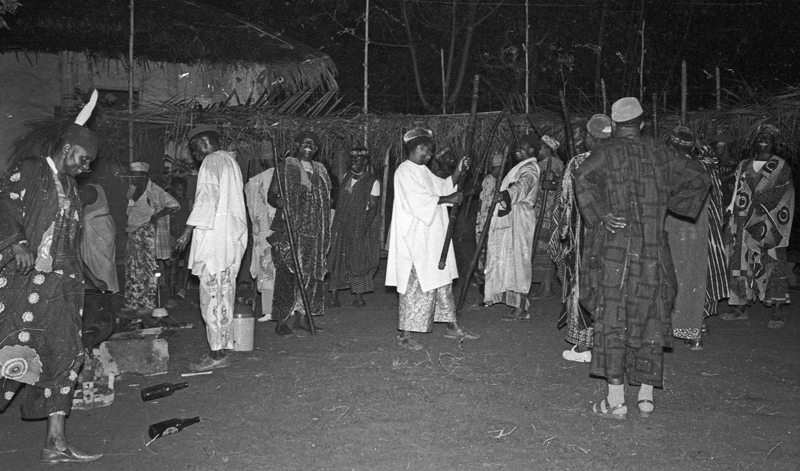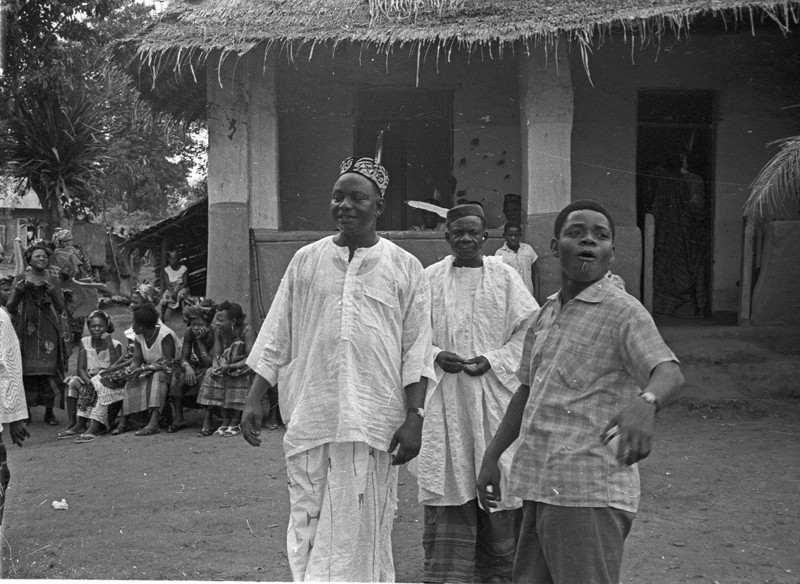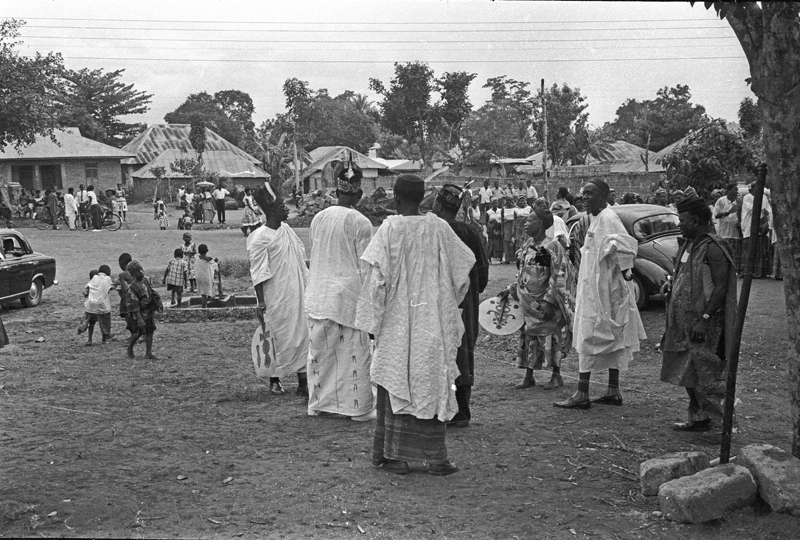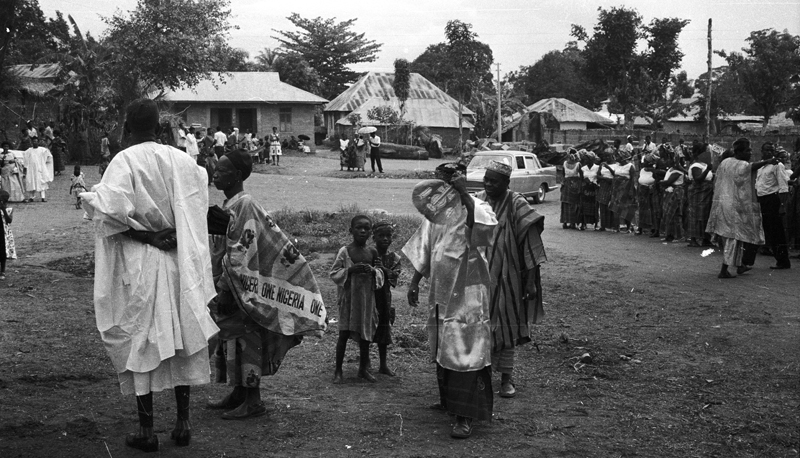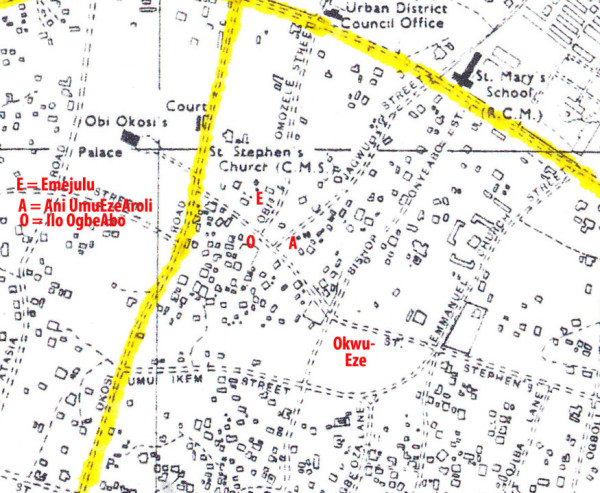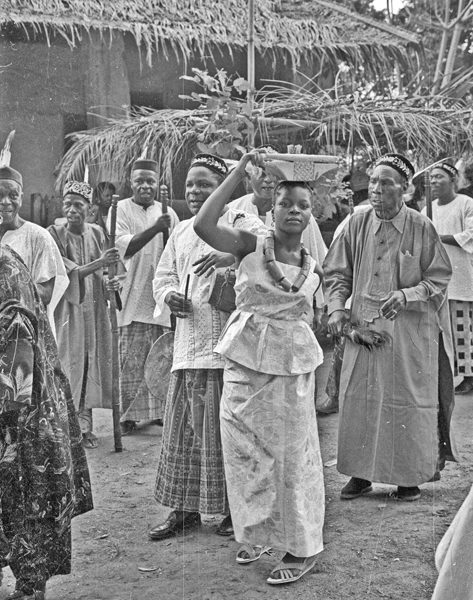[Note: Click on any image you may want to enlarge.]
As we have seen in the page on Polarization, Emejulu’s public Ozo rituals began on Friday afternoon March 24, when he entertained the Ivory Women Association (Otu-odu) as his mother was formally inducted into this titled group. I learn of this event too late to attend, but consulting with him later that day he tells me of the various stages of consultation and payments he has endured. 1
First, last wednesday he addressed the Ozo men of Obi-Omozele , his own subgroup of Umu-Aroli, doing Igba-Okonti (rubbing their ears), that is, notifying them of his intentions (with such gifts as kola nuts, 4 gallons of palm wine, one bottle of gin, and money, 12 shillings). This involves several stages of consultation (now reduced to a sequenceduring a single day). Then on Friday, he goes to the bigger circle (Ozo men of all Umu-Aroli) and they require more elaborate sets of offering (sheets of paper records are kept to monitor proceeds of the entire process). Then he “brings money for the ghosts” (ibu ego mmuo), involving a series of presentations, first to the Ôzo men of Umu-Aroli (summing in total some £250), then repeating this for all Ozo men of Umu-EzeAroli (including now those of Ogbe-Ozala and Ogbe-ndida, summing again some £250, and this is followed by a lesser sharing with all other Ozo men of Onitsha. Only the Ozo men of these groups are involved in these rituals.
Today, he has invited arrays of “Mother’s People” (Ndi-Nne-Ochie) which include those of his own mother (close family from Nnewi), family members from the Village of Iyawu (in Onitsha, where his mother lived while she grew up), and those of his mother’s mother (from Ozubulu town), his father’s mother (from Nkpor), his father’s father’s mother, from Umu-Ikem In Onitsha, and his father’s father’s father’s mother (from Umu-Ifejiofo in Umu-Dei). His wife has invited people from her own descent group (people from Ghana), and her mother’s people from Osomare (Ndi-Olu). All of these relatives come in distinct groups of males and females, each receiving gifts of rice, soup, and money representing gin, palm wine, etc.
I am present at Iba Omozele on Saturday night, when Emejulu comes before the Throne of all Umu-EzeAroli to receive ritual blessings from the senior lineage priests of that group. Below, Ononenyi Hector Emejulu sits on Ukpo Omozele, with Adazie Chukwudebe beside him as the Di-Okpala of Umu-Aroli (and indeed, of all Umu-EzeAroli). Three Senior Priests shoulld be occupying this throne, but the representative of Umu-Chimedie is otherwise engaged this evening.)
Inside this room are only Ozo men from Umu-EzeAroli sitting, though at one point Akunwata Bosah enters to salute the group, because he is a Daughter’s Child (Nwadiani) to Umu-EzeAroli). Kola nuts, palm wine, and gin are served to seated members, and Luke Emejulu and his wife enter and receive drinks from the two Senior Priests. then prepared food is brought forth, each titled man receiving his own plate.
Luke Emejulu enters together with his senior wife, and they are given food. (I am included in the recipient group by courtesy. When the Ozo man who will stand as surrogate for Luke sits to the left of the Senior Priests and takes up white clay in his hands (as the priests sprinkle water on assembled Ossissi staves), I am sent outside while the remaining ritual here is completed.)
The Ozo men from other villages than Umu-EzeAroli sit outside under their arbors, waiting for the ritual being conducted inside to spill out here. (Late March is the tail end of Harmattan season; it can still feel cold at night, as you may guess from the gear some people are wearing.)
Eventually Emejulu’s Ozo surrogate man2 dances out into the village square holding both of Emejulu’s brand new clay-white-covered Title Staves, wearing an eagle feather and white wrapper, his upper torso and face bathed in white clay.3 Behind him dances a nubile virgin girl, also clad in white and holding atop her head the Vessel of God (okwa-chi) symbolizing Emejulu’s newly purified social being. 4 In the image below, the face of the surrogate (covered with white clay) is framed by the two Ossissi staves he is holding.
Below, the girl carries the Okwa-Chi. She is one of Emejulu’s young daughters.
The Okwa-Chi shows some variation in shape, but the most typical form I saw is the one I show here at left and right (23cm L X 12 W X 10 D). It is carved from a piece of the Star-Apple tree (Udala, Chryssophylum spp.), with a boat-like shape, its contents flanked by elephant-tusk horn symbols, earth-mounds, with 5 Chi sticks represented as contained in a box in the center. (In some examples, the 5 sticks are emplaced more sharply rather than just outlined, as here.)
The pair (new Ozo man, virgin girl carrying symbol of purified self) is accompanied by a drummer, who performs the main orchestral effects. Gunfire reports are heard, and the characteristic horns of Ozo title-holders (Okwu-Odu) sound out as well. the dancers sing the characteristic Ozo song. 5 Many of the outside dancers are non-Umu-EzeAroli. The two men at center below, holding their Ossissi staves, are from Odoje Village.
While the characteristic dances and singing are performed, assistants lay out the food and drink which is due to the assembled title-holders (about 35 in number) . Early in the evening, two goats are led around for inspection by the assembly. Some men complain that one of the goats does not meet the standards of quality, and eventually an additional fee of 10 shillings is added to the amount the men will share. Here Below pieces of cooked goat meat are being cut up. The numbers of participants are tabbed by small iron disks each man carries.
Emejulu too eventually emerges and joins the nocturnal dance of all the Ozo titled men, borrowing a title staff from one of his new colleagues and proudly carrying his leather fan and wearing his eagle feathered cap. A full array of Ozo men from all parts of the town share the dancing, drink, and sacrificial goat meat that is cooked, distributed, and eaten there in the night.
As the night draws on “Money for Onitsha” (Ego Onicha) is calculated for distribution to all the Onitsha Ozo men present on the following day.
On the afternoon of March 25, Barrister, and now Ozo-titled Nnanyelugo Emejulu and his family come out into full public gaze bearing signs of their newly prestigeous status. Age Grades associated with him dance in the village square and are rewarded with their own private feasts. Lawyer friends of the barrister attend and go off to drink whiskey with him in his private quarters. the man at right below, a “been-to” (very recently returned from UK), sported the most elaborate “upper-class English accent” I ever heard in Onitsha (a real rarity). Standing between them is Akunne Enwezor of Umu-Anyo (Umu-Aroli).
Mr. Ikpeazu stands in front of a group of women assembled. these I think are members of Merci Erokwu’s Age-Grade (she sits at lower left).
A high point in the afternoon occurs when the Senior Chiefs (Ndichie-Ume) appear. They and their fellow chiefs are given places of honor in the gathering. Below, Odu Mbanefo II (holding his Azuzu fan at left) is greeted by now Nnanyelugo Emejulu (with his back to the camera), while Anatogu the Onowu (also wearing white) stands toward the right beside his fellow-Umu-Asele villager, Agbakoba the Asagwali (holding his Azuzu).
Note that across the street here (St. Stevens Road) some people from the directly confronting village of Ogbe-Abu stand, watching the festivities. This location marks a major division of the Royal Clan. On the far side, Ogbe-Abu is part of Oke-BuNabo, the Sub-Clan that has delivered the previous two (Okosi) Kings. This is Ilo-Ogbe-Abu, their main village square. (Note here the “One Nigeria” cloth the Asagwali is wearing, a very popular design in Onitsha at this time.)On the near side of St. Stevens Road stands the Iba Omozele, where Emejulu’s ritual was performed the previous night, along Obi Omozele Street. On the map below you can see the relationships clearly, with Ani-Umu-EzeAroli located also at St. Stevens Road, at the end of Ijagwu Street. This particular locus of confrontation between thesa two sub-clans is a location rich in history.
Below, a view of some part of the crowd awaiting the moment when the new Ozo man will be presented to the Mother Earth of Umu-EzeAroli.
Below, prestigeful visitors like the Onowu have been accorded seats of honor beneath one of the shaded arbors.
Again, Emejulu’s Senior Daughter appears, carrying the new Ozo man’s Okwachi emblem of self-purification, and accompanied by his orchestra of fellow Ozo men.
(I must confess that I found it difficult to turn my camera away from this gorgeous young woman, also stunning in her poise.)
The climax of this ritual occurs when the Ozo men of Umu-EzeAroli join to present the Ozo-elect’s surrogate to the Mother Earth shrine of King Aroli, each man wearing his feathered cap and thumping his Title Staff on the earth as the Ozo men dance in concert before the old, gnarled tree, making the rhythmic jangling sound that is sweet music to the ancestors buried nearby and chanting repeatedly, “Have Money! Have Money!” to celebrate the achievement being validated there. Below, Akunnia Mbanefo of Ogbe-Ozala leads the group (carrying his own very idiosyncratic version of an “Ossissi“, while the surrogate at right holds Emejulu’s two Ossissi Staffs. Emejulu follows behind Akunnia, holding an Ossissi borrowed from someone else.
Below, the Ozo-surrogate leads the way.
Below, the procession moves past Ijagwo Street. The virgin girl has fallen behind her Ozo-surrogate leader as the group moves faster.
Below, the group arrives at the Great Tree as younger people gather to watch from a distance.
Having saluted the Mother Earth, the group returns. Chukwudebe the Adazi (looking backward while holding his chief’s fan) leads the way, while Akunne Ediboss Okolonji loses no opportunity to titillate the crowd with some of his ribald humor (he is wearing the distinctive vertical-stripe shirt).
Members of Emejulu’s family, including an array of very beautiful girls, stand out in the crowd, with all their finery.
Afterward, the Ozo men of Umu-EzeAroli gather to make up a final accounting of the process.
Heavy rain falls for a while during the middle of this final afternoon ritual, and I hear one antagonist of Enwezor’s group sniffingly observe that that the ancestors are thereby displaying their anger over the pollution involved in accepting this particular title taker into the Ozo purified fold. Here, below, the elders take shelter in the face of this somewhagt disconcerting event.
But — I have to say it: Barrister Emejulu’s Ozo ritual and Emergence was the grandest I saw during my entire two years in Onitsha, was heavily attended by a variety of elites, and was actively enjoyed by nearly all Onitsha titled men and other participants. It was a rare delight for me to be granted the welcome to attend it.
Afterward, Mr. Emejulu’s overt presentation of character noticeably changed. Before taking the title, he displayed a quite gentle, accommodating demanor. Afterwards, he appeared (in the several scenes where I saw him in public) much more assertive, openly critical of others. Such were expected demmeanors of an Ozo-titled man.
- Henderson 1972:247-66, Orakwue 1953:11-37 , Bosah 1974:153-9 , Nzekwu 2002:113-42 each provide distinctive perspectives on Ozo title rituals and meanings. [↩]
- Because his father is still alive, Emejulu cannot fill the entire role of a Senior Priest; he cannot for example handle the Ossissi most closely linked with death [↩]
- According to tradition, Emejulu himself cannot actively assume this quasi‑ancestral stance because his own father is still alive. I regret I failed to get the name of this important man, who performed this duty as surrogate for a number of Ndi-Onicha while I was there. [↩]
- See Henderson 1972: 257-8 for a discussion of this prime symbol of male self. [↩]
- Henderson 1972:255-64. [↩]

